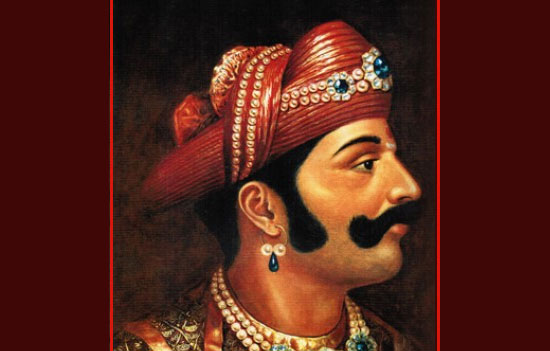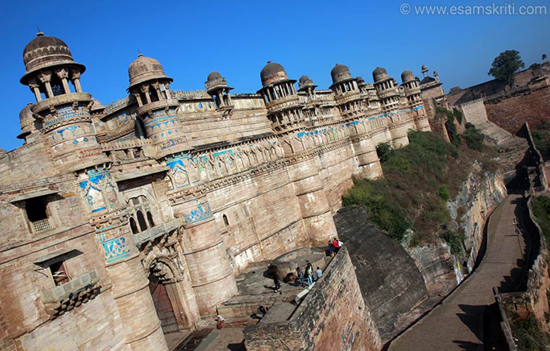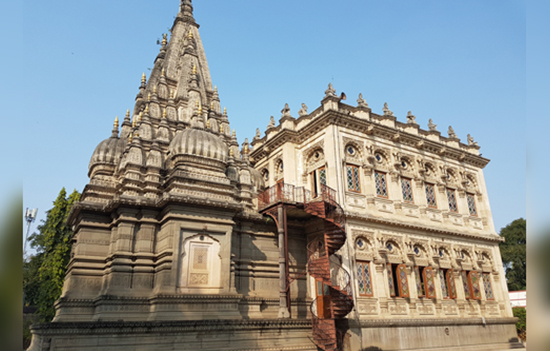- This article is a
historical sketch of the charismatic life of the great warrior Shreenath
Maadhavjee Shinde alias Patilbawa Mahhadjee (1730 to 1794).
Abstract
The third battle of Panipat (1761 AD.) was
a severe jolt to the Marathas, as lacs of Maratha soldiers gave away their
life, for saving their motherland against foreign invaders.
One of the bravest commanders of the Maratha Army was severely wounded but escaped death. But within six months re-united and re-arranged the army restoring the lost prestige. He was none other than the great warrior “Shreenath Madhavjee alias Mahadjee Shinde”. With time, he emerged as the most prudent commander and intelligent statesman, thus becoming a paramount power in the country.
Mahadjee was respectfully called Patilbawa by his courtiers. He was the only Maratha ruler who educed order out of the chaos of anarchy. The time period of Shreenth Madhavjee’s career can be said to be an episode in the perennial struggle which had been going on for eight centuries in India, between the social and religious system of the Hindus and the Musalmans.
‘Shreenath Madhavjee alias Mahadjee’ united Indian rulers against foreigners and re-established Hindu supremacy over the Moghul Empire.
His charismatic life has been published in a book, “Shreenath Madhavjee :Mahayoddha
Mahadjee Ki Shaurya Gatha”. So also, “Tawareekh E Shinde Shahi” is a famous research book where one can find authentic history of the Scindia Dynasty.
Introduction During the second half of the 18th century, the Maratha power reached its zenith under the most powerful chieftain of the empire, “Mahadjee Shinde.” With adversity all around and during the most difficult times in the history of India, this young warrior showed his matchless military skills and carried the Indian Flag (Bhagwa Zenda) from the River Bheema to the River Indus.
From the beginning of the 18th century
India saw fights among native powers. Many foreign invaders invaded and looted
this country. Many people from Arab, Iraq, Persia, Tooran, Khurasan,
Afghanistan, Kazakistan came to India, as they had heard that India is a land
full of opportunities. There was no central power to stop them and thus these
plunderers and invaders flourished. Some are still considered royal houses,
like Nizam of Hyderabad1, Musawi House of Lucknow also called as
Nawab of Awadh2, Nawab of Bhopal3, Nawab of Junagarh4, Nawab of
Rampur5, Nawab of Tonk6 etc.
The period when Mahadji was born was the period of great anarchy in India. During this time many battles and invasions were fought. For this time period, Richard Temple (Knight Commander of the Order of the Star of India; served as Chief Commissioner of Central Provinces 1867, Resident at Hyderabad, Lt. Governor of Bengal Presidency 1874, and Governor of Bombay Presidency in 1877) wrote a few lines in ‘Hindustan under freelance’, authored by historian HG Keene, “Never in the chequered history of all the ages had India known such an anarchy as that which then prevailed.” He writes further “… Mahadji Sindhia was the only one of the Maratha rulers who educed order out of the chaos of anarchy.”
Life Sketch
In the village Kanherkhed, near the famous
city of Satara in Maharashtra, Jankojirao (I) Shinde was the Patil, or Village
headman. He was in the service of the Maratha state under Peshwa Balaji (I)
Vishwanath Pant Pradhan Ballal.7
Jankojirao married Dwarkabai and had two sons namely Ranoji and Shambhuji the
younger son.
Ranoji joined the troops of Bajirao (I) in 1715 AD in the “paavlok”8 or Infantry when he was merely a 16
year old boy. Ranoji became one of the preferred commanders of Bajirao (I) due
to his valor and courage shown in successful campaigns of Karnataka, Konkan,
Guzrat and Malwa.
Ranoji married Nimbabai and Chimnabai and
had five sons viz. Jayaji (I), Dattaji (II), Jyotiba, Tukaji and Madhavjee. In
1732 AD, Madhavji was two years of old when he came to Ujjain with his mother
Chimnabai Shinde.
In the year 1734 AD the reconstruction of
Shree MAHAKALESHWAR Jyotirling temple by Shrimant Ranojirao Shinde was completed.
Mahadji was a four years then. During that time Chimnabai gave a Shivling to
Mahadji and ordered him to keep it on his head always, under the Pagadi.9 This event is considered a very important part in Mahadji’s life.
Unlike other Maratha Chieftains he was,
from childhood, taught Sanskrit and Arthashastra
by Sanskrit Scholars and Pandits of
Economics at Ujjain. Later on he also learned Farsi and Hindi from various
scholars of North India but majorly from Ujjain. Thus, he became one of the
most literate and educated person during his time.10
In 1739 AD Nadir Shah attacked India
causing wide devastation in North India. He sacked India and killed lacs of
Hindus. Chimnabai told this news to her nine year old child Mahadji, who was
infuriated on hearing this. Mahadji started his Military life when he was merely
a ten years old boy.
Mahadji got military training under his
elder brother Jayajirao (I) alias Jayappadada, the then ‘Silehdaar’ in the army of Shrimant Ranoji rao Shinde. He was also trained under his distant paternal uncle Sardar Swaroopji Shinde (s/o Kedarji (I) Shinde) during the earlier training sessions of his military career. Since 1742 Mahadji was constantly participating in state matters along with his elder brother Jayajirao (I).
In January 1743 Shrimant Ranojirao Shinde
conquered Gwalior and Delhi Badshah gave Sanad
of Zamindari to him on April 21, 1743. Mahadji’s illustrious father Shrimant Ranoji rao Shinde died on 19th
July 1745 at Shujalpur, where his cenotaph still stands with all the grandeur.
During 1745 to 1760 AD Mahadji fought
various battles, from Karnataka to Malwa, including Gujrat under the
commandership of his elder brother Shrimant Jayajirao (I) Shinde. He fought at
Chandravatiganj against Mirza Sukhawat and his military general Chonch Khan; at
Fatehabad against Pathan Qaudrattullah; at Badi Sadri against Khansahab Khurje
Ali; at Bhilada against Kunwar Jaysingh; and at Jalna against Mohammad Shah.
As mentioned earlier Ranoji had five sons,
all of whom were brave and fought numerous wars against foreign invaders. One by one they were killed in action 11 leaving the house full of
widows.
In 1760 India saw another Afghan Invader
Ahmed Shah Abdali. During the battle of Panipat Mahadji escaped being killed.
He was saved by a water carrier Rane Khan. After the heavy loss of Panipat, it
was his ambition that kept the Maratha Flag up and he re-arranged the Maratha
army under his banner in Gwalior.
 Malharrao Holkar.
Malharrao Holkar.
It was his vision to unite all national
powers under one flag. For this purpose he erased all the enmities between the
houses of Shinde and Holkar. These two chiefs of Peshwa took control of the
politics of Central India. There was a mutual benefit to both these houses
during the regime of Shreenath Mahaadjee and Subedar Malharrao (I) Holkar.
In December 1762 Mahadji got ‘Saranjam-E-Lashkar’ from Peshwa Madhavrao Balaji.
Unfortunately Malhar rao Holkar died in
1766 AD and the good rapport between these two houses ended when the next ruler
Tukojirao Holkar created diplomatic obstructions in the matters of Maratha
state which Mahaadjee was managing proficiently.
After the death of Malharrao Holkar, Peshwa Raghunathrao tried to confiscate the estate of Holkar but Shreenath Mahadji was the only person who supported Ahilyabai and asked Raghunathrao to allow Ahilyabai to continue the management of Indore & Maheshwar estate. Due to the military power of Mahadji, Raghunath rao agreed to let the estate matters of Indore to Ahilyabai. This way Shreenath Mahadji became a savior of the Holkar’s Indore Riyasat.
After Panipat war, Raghunath Rao planned
to take control over the Peshwa-ship, for which he tried to win over various
Maratha leaders at Poona court. It created much trouble to Mahadji as Raghunath
Rao never wanted to make Mahadji chief of Shinde-shahi. Raghunathrao made
Kedarji Shinde heir of the Shinde dynasty. It was in 1768 that Peshwa Madhavrao
Balaji Bhatt announced, on Makarsanskranti, Shreenath Mahadji as the legal heir of Shinde
dynasty.
On January 18, 1768 Mahadji was formally
invested with title as the chief of Shinde-shahi.
 Gwalior Fort.
Gwalior Fort.
Shreenath Mahadji’s fight back to get Gwalior
In 1743 Delhi Badshah Mohd Shah Rangeele
gave the authority of Gwalior to Ranoji Shinde. But when Shreenath Mahadji was
busy in war against Rathod chief of Jodhpur in 1755, Gwalior was captured by
Rana Bhim Singh of Gohad.
After the victory of Nagaur, Rajasthan Mahadji returned and conquered Gwalior in 1756. In 1763 when Mahadji was busy in war at Miraj, Maharashtra. Once again the Gohad army again captured Gwalior. After winning Miraj, Shreenath Mahadji came back to Gwalior winning it again from Gohad’s Rana. In 1780 when Shreenath Mahadji was busy in the first Maratha-Anglo war at various places in Maharashtra, Malwa and Gujrat, Rana Lokendra Bahadur Chhatrajit Singh of Gohad was re-installed at Gwalior by the East India Company. Shreenath Mahadji fought, for several months, to win Gwalior.
Finally, in 1738 he was successful in
winning Gwalior third time in a row against Rana of Gohad. To resolve this
problem forever Mahadji pushed his army to Gohad and after a long battle won Gohad
too.
Shreenath Mahaadjee Shinde defeated the powerful Afghan general Muhammad Shah Abdali in 1785 (relative
of Durrani Ahmed Shah Abdali) and won Lahore for the second time. Thus he
established Hindu Rule till Attock (on eastern bank of River Sindhu, in modern-day
Pakistan).
When he won Lahore he took the emerald
studded Silver gates of Somnath Temple, initially looted by Afghan invader
Mahmud Gaznavi in the 11th century. Due to religious reasons the Brahmins of Gujarat never gave permission to reinstall these gates again in the temple. Hence, Mahadji sent these gates to his capital Ujjain. One can still see these gates there.
 Chhatri Pune of Mahadji Shinde. Pic by Uday S. Kulkarni.
Chhatri Pune of Mahadji Shinde. Pic by Uday S. Kulkarni.
Conclusion
He was serene in his nature. Shreenath
Mahaadjee Shinde always supported the cause of Maratha Empire and was true to
his master the Peshwa. Although the Peshwa was much weaker in terms of military
power in comparison, nevertheless Shreenath Mahaadjee always showed due respect
to the Peshwa.
At length, through his superb military
control and administration, Shreenath Madhavjee Shinde became the paramount power
of the nation and the de-facto ruler of Hindustan. He successfully administered
political matters till his death.
Mahadji was the only one Ruler of India
who, from Moghul Badshah, released the Shahi-firman for the prohibition of Cow-Bulls Slaughter in whole country. Shreenath Madhavji alias Mahadji Shinde personally ensured that this Firman was executed and did not remain on paper. Thus, he was suitably titled ‘Gaurakshak’.
Recent Advances
An historical sketch of the charismatic life of the great warlord Shreenath Madhavjee is written in the book “SHREENATH MAADHAVJEE: MAAHAAYODDHA MAHAADJEE KI SHAURYA GAATHAA” (published in 2013) in which his relations with The Peshwas of Poona, The Chhatrapatis of Satara, The Badshah of Delhi, The Nawab of Lucknow, The Nizam of Hyderabad, other Maratha chieftains viz Holkars of Indore, Gaekwars of Baroda Bhosles of Nagpur, Kachhwah Chief of Jaipur, Rathod Chief of Jodhpur, Rajput chief of Machhedi, Sisodiya Chief of Udaipur and the East India Company are covered in detail.
In this book description of Shreenath Mahadji’s major wars is given. Views of various historians are also mentioned. This book is divided into five chapters namely first starts with birth, second gives details of the third battle of Panipat, third chapter gives the details of his struggle for supremacy, fourth shows his achievements, fifth deals with his last days and ends with his death and legacy.
The book “Shreenath Madhavjee: Mahayoddha Mahadji ki Shaurya Gatha” is completely a research work where not a single line has been written without ample proof, thus making it an authentic book of history. Hundreds of books (English, Hindi and Marathi) were referred to while preparing notes for this celebrated book.
Tawareekh-E-ShindeShahi (published in
2017) is an award winning research book, elaborating the glorious history of
India under the rule of Scindia rulers. This research book is a comprehensive
book with all micro information about the establishment and extension of the
Hindvi Swarajya in North India, under the impeccable command of Shreenath
Mahadji Shinde. The book consists of rare photographs, portraits, and images of
coins, original letters, and other historical documents which are pure bliss
for history lovers.
Also read
1.
Invasion
of Nadir Shah
2.
Invasion
of Ahmed Shah Abdali
3.
Third
Battle of Panipat
4.
About
Malharrao Holkar
5.
Mahadji Scindia – his life and death
6.
The saga of Shivaji – from Agra to Salher
References
1. Forebears of the Asaf Jahi dynasty came
to India from Samarkhand, in Central Asia, but the family actually originated
from Baghdad. Qazi and Shaikh ul-Islam of Bokhara (Presently in Uzbekistan)
migrated to India and entered the Mughal service in 1641.
2. The Nawabs of Awadh were Shia Muslims of Persian origin. In 1724, Sa'adat Khan established Awadh state. Of all the Muslim states and dependencies of the Mughal Empire, Awadh had the newest royal family. They were descended from a Persian adventurer called Sa'adat Khan Mir Musawi.
3. Dost Mohammad Khan (1672–1728), an Afghan soldier of Warakhzai Pathans, in the Mughal army.
4. Descendants of the Usman-khel of the
Yusufzai Pathans from Afghanistan, they entered India under Usman Khan Babi, a
follower of Emperor Humayun.
5. Faizullah Khan was ethnic Pashtun and
belonged to the Bangash tribe of the Ghurghusht pashtuns. His family migrated
from Kurram (now in Pakistan) and settled in India during the Mughal Empire.
6. Afghan Salarzai Pathan tribeman named Taleh Khan, from Buner was the progenitor of this family. Taleh Khan, migrated to India during the reign of Badshah Muhammad Shah ‘Rangeeley’.
7. Peshwa Rojkeerd.
8. Ghadani daftar of Peshwa’s Court.
9. The Last Maharani of Gwalior; Chapter
Two, Pg 72. By Rajmata Vijyaraje Scindia and Mr. Malegaonkar.
10. The above written line is concluded
from the letters of Pandit Mahadjipant Karkare alias Guruji Ballal (Teacher of
Peshwa Vishwasrao and Peshwa Madhavrao senior) and Nyaymurti Ram Shastri (Chief
Justice of Peshwa Court).
11. Shrimant Jayajirao (I) Shinde was
treacherously killed at Tavsar, Nagaur, Rajasthan during his war with Rathod
Chief of Jaodhpur on 25th July 1755 AD. Shrimant Dattajirao Shinde was
perfidiously killed at Buradi Ghat of River Yamuna in Northern Delhi during his
battle with Rohilla chief Najeeb Khan and Qutub Shah on 10th January 1760 AD.
Tukaji Shinde was killed in the battle of Panipat on 7th January 1761, while
fighting against the rohilla chief Najeeb Khan & Shah Pasand Khan of Afghanistan.
Shrimant Jankojirao (II) Shinde, son of Shrimant Jayajirao (I), was captured
from the battlefield and next day killed by Afghans in their camp at Panipat on
8th January1761 AD.